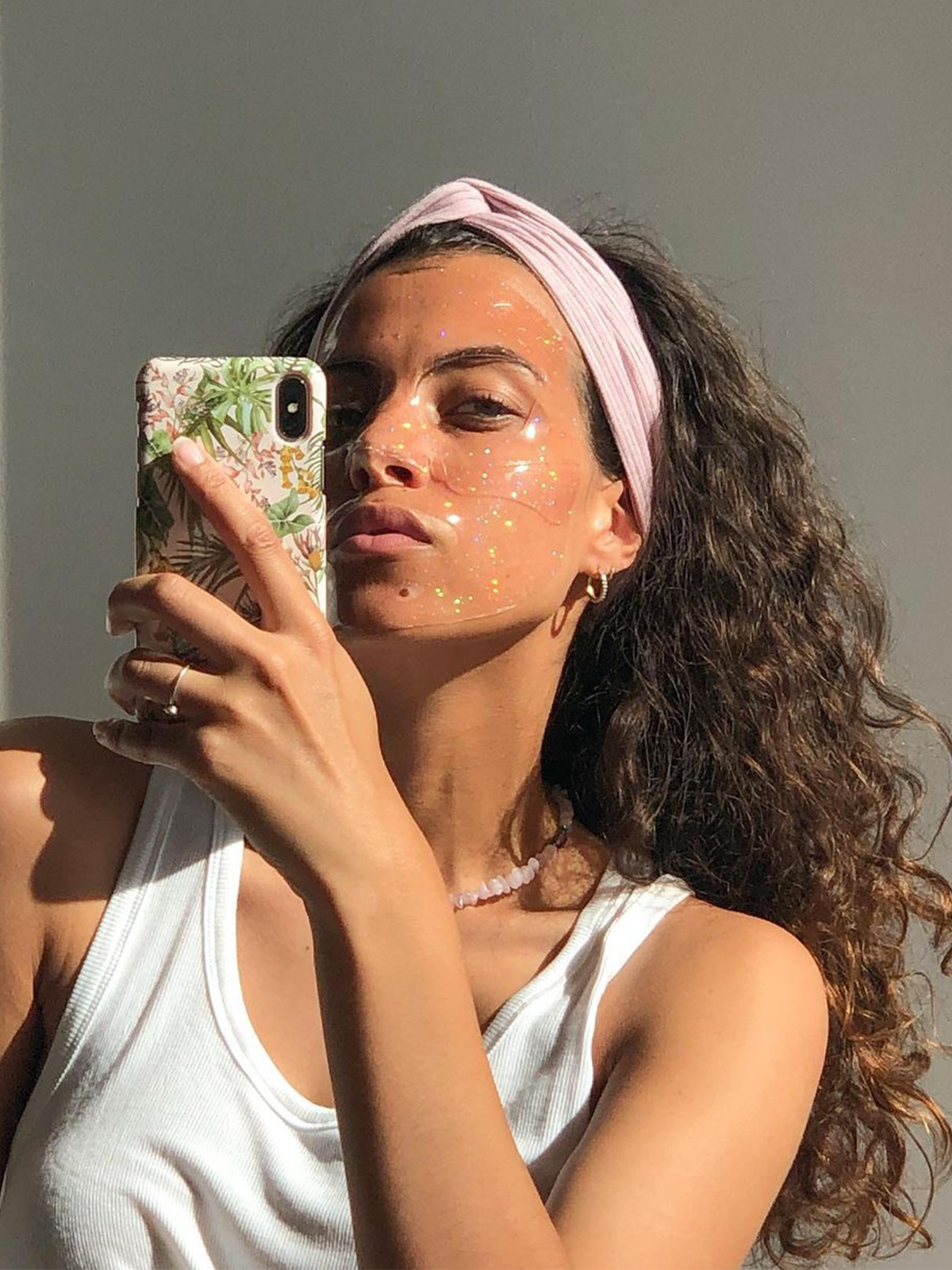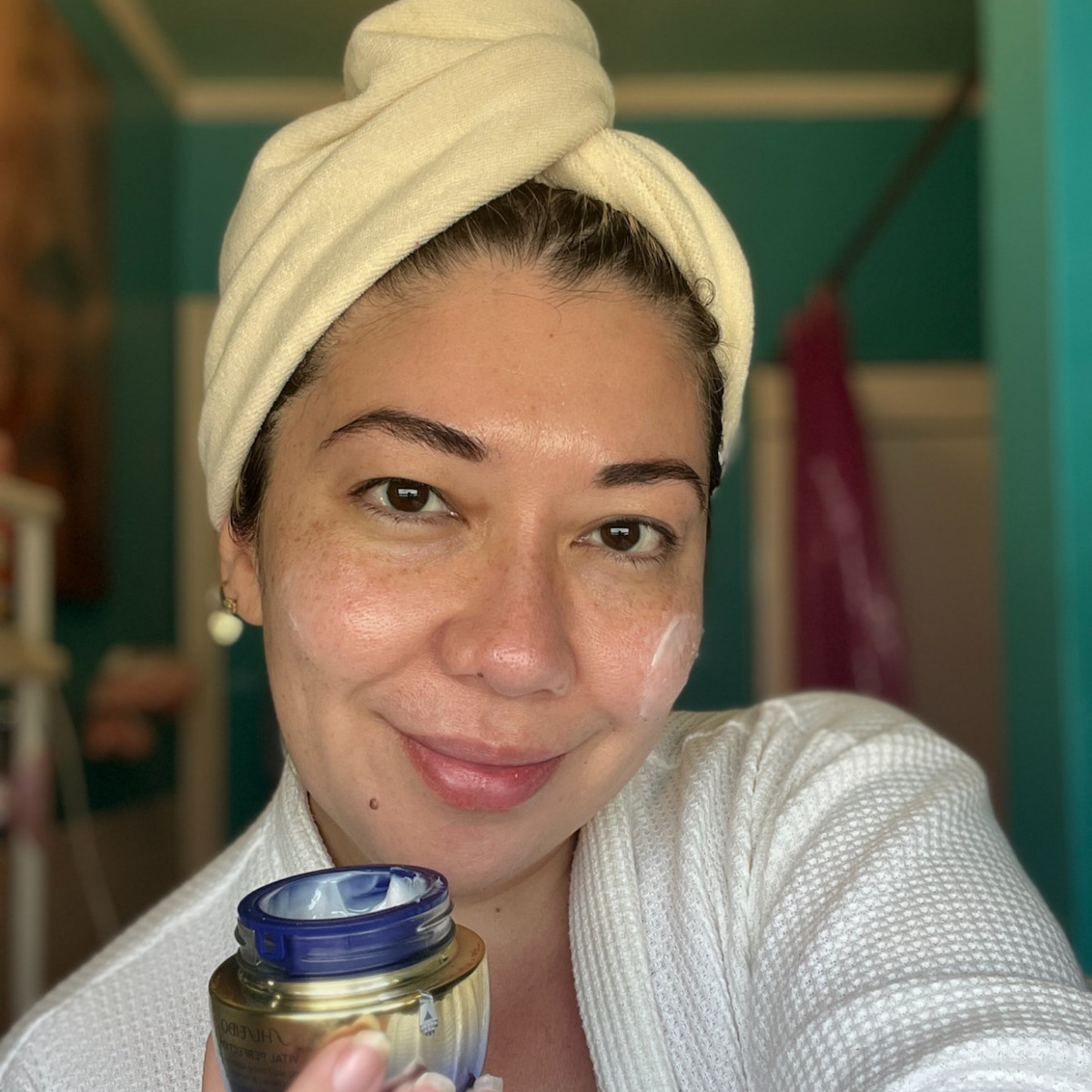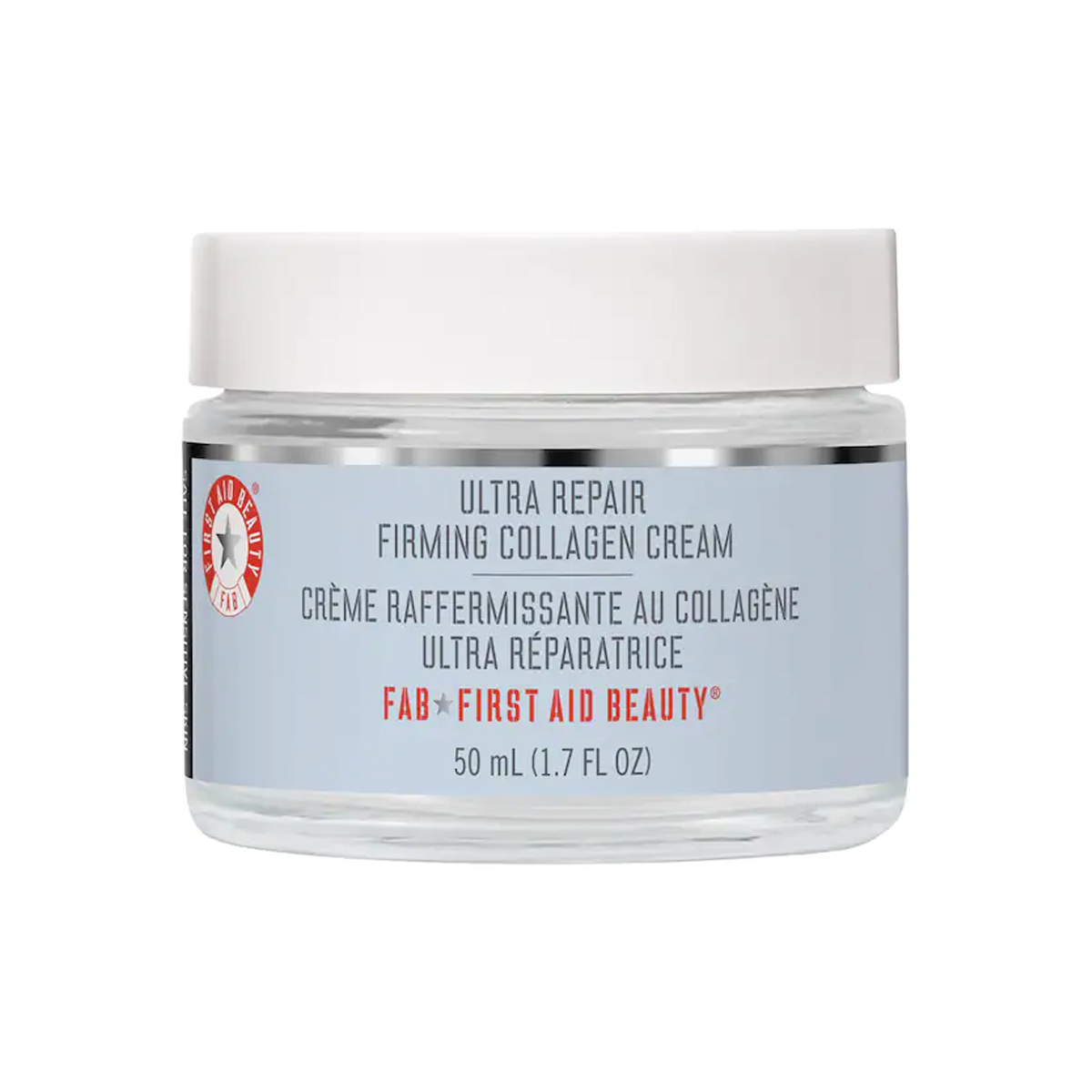Dermatologists Agree: This One Treatment Is the Key to Tighter Skin

Oh, firm skin. It's one of those overarching skincare goals many of us hold, but not everyone is totally clear on how to achieve it. With all the products out there touting the ability to plump, tighten, and otherwise boost elasticity, it's easy to get swept up in an ingredient frenzy. But if you're serious about achieving tighter, more lifted skin, then stimulating collagen in the skin is of the utmost importance, and one of the best ways to do that is by undergoing treatments involving lasers.
Now, we've learned that there are, indeed, plenty of topical skincare solutions out there, like at-home peels and certain serums, that can help this process, but experts agree that skin-tightening lasers can get the job done faster and with even better results. But what kinds of lasers are best for this purpose? Do they hurt? Is there downtime? These are all questions we need answers to, so we caught up with Corey L. Hartman, MD, FAAD, a Birmingham-based board-certified dermatologist, to give us an A to Z breakdown on skin-tightening lasers and make sense of how they might be a beneficial treatment option to explore. As an expert who specializes in laser treatments, he had a lot to say. Keep scrolling for the master class.
How do skin-tightening lasers work?

Skin-tightening lasers may sound like magic, but the way they function is actually super practical. They stimulate our skin's collagen producers, known as fibroblasts, by delivering energy deep into the skin to increase the collagen production already taking place. Makes sense, right? Skincare pros and enthusiasts are well aware that the protein collagen—a vital building block in the skin that gives it its thickness and keeps it looking plump and full of volume—is one of the pillars of firm, youthful-looking skin. The not-so-great news? Collagen production starts waning pretty early on. "Those fibroblasts get lazy, and the collagen production just is not what it once was. Our production starts to decrease 1% every year after the age of 22," Hartman explains. While that statistic might be a little frightening, it's important to remember that this loss is totally natural, even if it's not exactly ideal if maintaining firm, tighter-looking skin is high on your list of priorities. Further, this is where lasers come in and can truly make a difference.
What are the main types of skin-tightening lasers?

According to Hartman, there are several different modalities that can be used to tighten the skin. With time, the technology has gotten better and better at serving different skin types. Below, find a breakdown of some of the top lasers Hartman works with as well as some important factors to consider when deciding which laser is best for you.
CO2 Lasers: "There have been devices on the market that have been able to tighten certain skin for many years from a resurfacing standpoint," Hartman explains. CO2 lasers, which he calls the gold standard in resurfacing lasers, do their thing from a position of really affecting the outermost layer of the skin, the epidermis. This means CO2 lasers start on the skin's surface and travel deeper and deeper, so they're able to create a lot of change on all the layers of the skin it encounters as its energy is deployed down into the deeper layers where collagen production happens. Sounds great, right? Well, it is… unless you're a person with melanated skin. "Because the epidermis is where our melanocytes live—that's where our pigment-producing cells are—these aren't lasers that everybody can safely use and have the reassurance that the skin won't lose pigment as a result," says Hartman. Due to its generally higher oil content and built-in sun protection from melanin (imagine an automatic SPF of about eight to 10), Black and brown skin won't typically age in ways that would require these types of lasers anyway, Hartman points out. (Price: $250 to $5000 depending on your location, the type of laser used, the number of treatments needed, and the size of the treatment area. Speak to a qualified professional for a quote.)
Fractionated Lasers: Over the last decade or so, Hartman says fractionated lasers (Fraxel is a popular one) have emerged as the first color-blind resurfacing lasers suitable for melanated and non-melanated skin, without the risk of negatively affecting melanin production. Aside from resurfacing pigment and tightening the skin, Hartman says these lasers can treat intense scarring on the face and elsewhere and are the go-to for stretch marks. "It helps with acne scars, wrinkles, and fine lines, and we also use it for hypertrophic, thick scars and keloids. Once the keloid is not active anymore, [the laser] can seal it down to help to improve the appearance and also stop that cycle where it just flares up all the time," Hartman explains. (Price: $500 to $2500 depending on your location, the type of laser used, the number of treatments needed, and the size of the treatment area. Speak to a qualified professional for a quote.)
Radiofrequency and Radiofrequency Micro-Needling: The most exciting breakthrough in skin-tightening laser technology, Hartman says, has been the development of radiofrequency micro-needling over the last five to six years. "It has truly changed the game because, instead of delivering the energy from the surface of the skin, where you have to interface with the epidermis and risk discoloration or depigmentation, these devices deliver heat through titanium-coated needles that bypass the epidermis and get into the dermis, where it's going to be most effective to really tighten skin. When the first radiofrequency devices came out, they didn't involve the needles, and we saw the same issue where we had this heat that we needed to get down to the dermis where the fibroblasts are located so that we could stimulate collagen production. But if you heated brown skin beyond 44°C, you would cause a burn and cause hyperpigmentation, which is not fun. So the technology took a leap forward, where, instead of just resting on the surface, now it delivers the heat through those titanium-coated needles, which is so much safer and completely color-blind." (Price: $300 to $2000 depending on your location, the type of laser used, the number of treatments needed, and the size of the treatment area. Speak to a qualified professional for a quote.)
Who are the ideal candidates for laser skin tightening?

Now that you've learned about the different lasers available, you might be curious to know who the best candidates are for experiencing these high-tech treatments. Taking into account the limitations laid out above regarding skin tone and the different lasers available to make up for them, Hartman actually thinks everybody can benefit from skin-tightening lasers. There's a catch, though. "If you have more collagen and more fibroblasts to work with, then you're going to be a better candidate because we're stimulating those things to work harder," he says. He gave me an interesting analogy that helps clarify this point. "Who's a better candidate for hair-replacement treatments—somebody who has good, healthy follicles or somebody who has scar tissue and no healthy follicles? You want to have something there to work with, so the more depleted your skin gets of collagen and the fewer collagen-producing cells that you have that are actually working, you may not get as much of a response as somebody else who has those soldiers already operating." Makes total sense! So just remember that lasers won't be able to replace or replenish depleted collagen cells in the skin, but they'll be able to work with the healthy ones that still remain.
What are the most important aftercare protocols following a laser treatment?

I don't know who still needs to hear this, but sun protection deserves a top spot in any skincare routine. It's especially important after your skin has been in contact with lasers, though. "Whenever you heat your skin up, it's going to be more vulnerable since it's in a recovery and healing state," Hartman explains. "You don't want to subject it to any unnecessary UV light because that is the time where you're going to be more susceptible to causing hyperpigmentation and untoward effects. Does it happen all the time? No. But I wouldn't do any of these lasers and then go out on the beach and just hang out with no protection at all." He recommends physical sunscreen of SPF 30 to 50 to be safe. Another note Hartman mentioned was to be conservative about any other treatments in the weeks following a laser treatment: "I would also not do injectables for a couple of weeks just to make sure that everything settles." The takeaway? Let's just keep it as calm as possible and always give ourselves a cooling-off period of about 14 days to recover from any procedure before going in for another.
Editor-approved physical sunscreens to have on hand:
Can you replicate the effects of in-office laser skin-tightening treatments at home?

While lasers are great, Hartman is very clear that they're not essential for maintaining beautiful skin. "There's a lot to be said for a good skincare regimen and devices," he tells us. "Lasers are a nice adjunct if you can afford them." In terms of the must-haves for encouraging collagen production, he recommends incorporating the following products.
Retinoid

Retinoid helps to resurface the skin by encouraging healthy skin turnover to keep those collagen-producing cells in tip-top shape. If you can't get your hands on an ultra-strong prescription (or if you just aren't ready for that), a potent OTC option like this one will still do wonders.
Antioxidants
Hyaluronic Acid
Microcurrent Device

If you can't swing in-office treatments right now, Hartman thinks at-home microcurrent devices are a great substitute to consider. "I do think that some of these microcurrent devices that are used at home, like the NuFace, are pretty good," he says. "It takes more work, as they tend to have to be used every day, and there is some slight discomfort that you have to get used to, but if that's the best that you can do, I say go for it." He says diligent use of a device like this will absolutely make a difference in the long-term.
Micro-Needling Tool

Hartman also says occasional at-home micro-needling can help boost collagen to mimic the effects you might get from laser treatments. "I think that they can be safe, but the more effective they become, the less safe they become," he cautions. "You have to get to a certain depth of penetration to really make an impact, but when you get to that depth, you also run the risk of introducing infection." As a rule of thumb, he recommends sticking to the tools marketed for at-home use and not being tempted to order the sketchy, professional-level devices you might see available on Amazon or eBay. "You'd be surprised at the sophistication and level of device that you can get even on Amazon that can truly cause some damage in the wrong hands. We tend to think the stuff that's available over the counter or online is not going to be strong enough or robust enough to really make an impact and cause problems, but I've been shocked by some of the things that people are able to find on their own," he explains.
Shop more collagen-boosting must-haves for tight skin:


This LED light mask stimulates collagen from different receptors than the ones that can be stimulated by antioxidants, retinols, peels, and other topicals, making it a great device for rounding out your collagen-production efforts.

This vitamin C serum is massively popular on Amazon, with over 60,000 reviews touting its efficacy despite the shrunken price tag. We love a deal!Up next, According to Reviews, These Are the Best Body Creams to Help Firm and Tighten
Courtney Higgs is a Cancer sun, Libra rising beauty enthusiast with six years of experience in the editorial space. She was previously Who What Wear's associate beauty editor after spending many years working at InStyle Magazine. She graduated from California State University, Northridge, with a BA in communication studies and pivoted to editorial after spending her college years working in the legal field. Her beauty philosophy is simple: She believes there are no wrong answers and that discovering our favorite beauty products and rituals is a journey, not a sprint. When she's not geeking out over products, she can be found adventuring around L.A. with her fiancé; watching reality TV with their French bulldog, Bernie Mac; or relating way too hard to astrology memes.
-
 My 53-Year-Old Mom Can't Stop Texting Me About This Firming Serum: "My Skin Looks Good Without Makeup Now"
My 53-Year-Old Mom Can't Stop Texting Me About This Firming Serum: "My Skin Looks Good Without Makeup Now"Plus, how it fared on my 25-year-old complexion.
-
 Retinol Products Scared Me, TBH, But This French 5-in-1 Formula Totally Shifted My Stance
Retinol Products Scared Me, TBH, But This French 5-in-1 Formula Totally Shifted My StanceIt does it all.
-
 Is the Lyma Laser Pro *That* Much Better Than the Original Celeb Fave? I Tried It for 49 Days
Is the Lyma Laser Pro *That* Much Better Than the Original Celeb Fave? I Tried It for 49 DaysSee how it measures up.
-
 Salma Hayek Pinault's Key to Youthful Skin? Moisturizer Sandwiches and This "Turkey Neck" Treatment
Salma Hayek Pinault's Key to Youthful Skin? Moisturizer Sandwiches and This "Turkey Neck" TreatmentNo retinol, no peels, and absolutely no injectables.
-
 My 56-Year-Old Mom and I Agree—These Peel Pads Are the Secret to Brighter, Smoother Skin
My 56-Year-Old Mom and I Agree—These Peel Pads Are the Secret to Brighter, Smoother Skin"I'm literally addicted."
-
 14 Strategic Skincare Products That Have Totally Saved My Dry, Perimenopausal Skin
14 Strategic Skincare Products That Have Totally Saved My Dry, Perimenopausal SkinHint: They all have one thing in common.
-
 I'll Be 30 Next Year and Want the Best Skin of My Life—5 Swaps I'm Making
I'll Be 30 Next Year and Want the Best Skin of My Life—5 Swaps I'm MakingI'm prepping now.
-
 This Hero Japanese Skincare Ingredient Transformed My Dry, Perimenopausal Skin
This Hero Japanese Skincare Ingredient Transformed My Dry, Perimenopausal SkinI'm obsessed.













